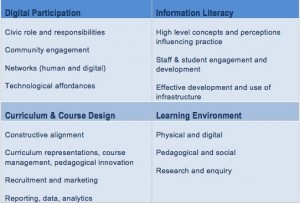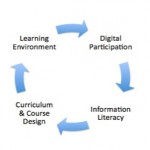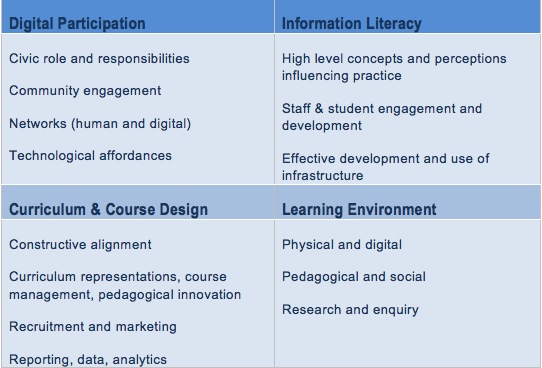Continuing from my last post, the next part of the programme technical journey focuses on Cluster B projects: T-Sparc, PALET, UG-Flex and PREDICT who all had a broad common theme of organizational change.
In many ways this cluster represents the ‘business end’ of the programme. With Cardiff, Greenwich and City Universities all having pretty robust institutional system integrations in place before the programme started. The programme was a way to develop these existing systems to allow more effective and pedagogically driven processes to be developed and incorporated.
T-SPARC
*Project Prod Entry
Unlike the other 3 projects in this cluster, T-Sparc didn’t have as robust an infrastructural starting point, however providing a means for organizational change around curriculum design was a key driver.
The project had four key aims;
“• To inform programme design activity through the improved provision of relevant information to those stakeholders engaged in curriculum design.
• To redesign the ICT infrastructure which supports the workflow of curriculum design and programme approval processes.
• To develop and pilot mechanisms for supporting, through electronic means, course team discussion during their programme design activity.
• To develop and pilot the electronic representation of programmes and underpinning evidence for the purposes of approval.”
One of the key findings from previous technical conversations with the programme was the number of instances of Sharepoint, and its central role for a number of projects. As I commented then, that probably wasn’t that surprising given the that over 90% of UK universities have an installation. The T-SPARC project initially were looking towards utilizing Sharepoint as a definitive document repository and take advantage of its document version control abilities. However as the project has progressed, it has evolved to become the central part of their curriculum design system. A number of workflows were created from their stakeholder enagement and baselining processes using combination of modeling techniques including experiments with BPMN, UML and Visio as outlined in these blog posts.
The team were also able to negotiate dedicated time from an specialist Sharepoint developer in the institution to work with them using an agile development process. A dedicated area in the project blog documents their experiences in working with Sharepoint, and agile project methodology. The posts in this area are particularly useful in sharing real experiences of a project working with agile methods, as well as with corporate IT services – worth a look if you are new or going to be working with others new to this type of approach. Their prototype PADS (programme design and approval system) system is now being trialed by eight programme teams. A key challenge in terms of sustainability and embedding is how to ensure that the system is integrated into wider institutional initiatives such as the recent implementation of SITS. However, as with many other projects, cultural interoperability is perhaps more of a challenge than its technical counterpart.
Perhaps the leading light in terms the use of video narratives, the T-Sparc team have invested time and money into capturing the stories and experiences of their key stakeholders (staff and students) included a very innovative video baseline report. The team have used a mix of video caputure methods including flipcams and the ipad based MiiTuu sytesm. The later is a relatively new development which the team have been using with students and employers. The allows exporting and sharing of questionnaires across devices and allow for time reductions in the setting up and gathering of data. The system utilizes i-Tunes, BCU has an institutional wide itunes provision, so again sharing is simplified. The use of video for personal reflection is fairly mainstream within the institution now too. The team have made extensive use of free editions of video editing/compression packages (Handbrake, Microsoft Expression), however they are still searching for a real time video compressor. Ideally one which would compress on the fly and have an automagic deposit to repository feature to suit their needs – and budget. Again storage for video is an issue (as highlighted in this post) – is this where cloud storage could play a useful institutional role?
The team are also developing a Rough Guide to Curriculum Design which is outlined in this post which will synthesis all aspects of the project.
PALET
*Project Prod Entry
In contrast to T-Sparc, the PALET project was working within the context of a fairly robust internal technical infrastructure based largely on IBM websphere and Lotus tools. Institutionally, the Lean methodology was also being widely supported. Cardiff also had previous experience of Enterprise Architeture and, as the project developed, through other institutional projects, links to the JISC FSD programme.
The PALET project’s aims were to:
“Utilising the Lean Thinking methodology for process improvements, the PALET project will develop revised procedures for the approval of new programmes to create a more agile, efficient and flexible approach to the design of new curricula and the subsequent programme approval process. In the context of the University’s Modern IT Working Environment (MWE) project, a service-oriented approach will be utilised to develop a toolset to support academic and support staff through each stage of the new programme approval process, which will also ensure that the resulting programme and module information is clearly defined and can be seamlessly utilised by other business applications.”
Key to the project has been the creation of a single data source which contains all relevant curriculum design and approval information which can be easily re-purposed and accessed by various stakeholders. Interestingly the project has ended up taking a scaled down approach and building their own webservices and not using IBM tools.
They have moved away from using websphere as their main data source and SITS is now core for the storage of course related information. This has allowed the team to write their own webservices using Grails, and taking restful approaches and the Groovy programming language. This was quite a sea change for all involved as outlined in this blog post. As highlighted in the post, the team have found this experience very useful, and this generic web services approach/architecture is now being rolled out in other parts of data provision in the University. This should help with sustainability and the embedding of more data services/ provision as and when needed. Again the successful managing of change during the lifecycle of the project has been key for everyone. Sometimes a simple approach is best.
Parts of the their larger infrastructure remain and there are now better connections with for example Lotusnotes and bringing feeds and topics into one overarching portal for end users. However, the team have developed a dedicated portlet for course information which links to the main websphere portal. Details of which are outlined in their portlet technical specification. The work done on the underlying technical infrastructure ensures that the progress in terms of redesigning course and module templates can be fully utilised.
Like T-Sparc, the team are still analyzing the need for XCRI, and are confident that they could easily create a feed if need, however there still aren’t key internal drivers for this as yet.
A full technical specification for the project is also available.
UG –FLEX
*Project Prod Entry
Like PALET, UG-Flex also had a robust infrastructure (based largely on SunGard Banner ) in place which they planned to build on.
“We envisage that our technical outputs will be of use to other institutions using SunGard’s Banner system and we plan to feed these outputs into the European and international Banner community. The project also intends to share the lessons learned about the challenges of working with a proprietoriaml product based applications with the wider education community.”
Although the institution did have dedicated business analysts the experience of the project has had an impact on approaches to business processes in general and the use of and techniques applied for modelling. For example although their Business Analyst were conversant with various visual modeling techniques and languages (BPMM, BPEL, UML) to illustrate and developed technical infrastructures, having resource dedicated to the project allowed them to work at a far greater level of detail. This experience has allowed the for the processes used in the project be incorporated into day to day techniques in other large scale projects throughout the University. Exploration of TOGAF methodologies is ongoing and staff are undertaking accreditation training..
In previous conversations with the team, they had expressed an interest in XCRI. Greenwich has been successful in gaining one of the JISC Course Data projects and it is now embarking on their xcri-cap production stage. A nice example a synergistic relationship with the outcomes and findings of UG-Flex, and future institutional planning e.g. KIS returns.
Through Banner, there is use of IMS enterprise compliant tools, but there has never been a plan to develop anything at the enterprise level. However, in terms of future developments there are some major changes for the IT team. The new versions of Banner are now component based as opposed to Oracle based. Whilst on the one hand this does allow for greater flexibility and more agile approaches, as well as an improved UI; on the other this is a major change for some more traditional database developers, and so an issue for staff skills and development.
Again we had talked about Sharepoint in previous discussions, and concerns had been raised about its suitability for managing data as opposed to documents which it has undoubted strengths in. Now there is a fully supported installation in their Business School. Preparatory work is been undertaken around implementing some automated workflows, in particular around QA processes which have been developed through UG-Flex. As an adjunct to this work, and UG-Flex, a personalized timetabling service is being developed and trialled in the Business School. The team have also kindly agreed to write this up as a guest post in the CETIS other voices blog.
During the project lifecycle the institution has also migrated to Moodle (more details of some of their approaches and the lesson learnt about stakeholder involvement and process mapping have been included in this summary post from Lou McGill )
Overall the team have found that the UG-Flex project has been exemplary in terms of academic needs driving developments, and not the IT department. Particularly with the VLE migration, there is a strong sense of ownership from the academic community as they feel they have been fully part of the decision and migration process.
PREDICT
*Project Prod Entry
PREDICT was again a project with a pretty robust architecture and like UG-Flex, they have noticed a perceptible change in attitude during the lifecycle of the programme. The use, and understanding of the term, Curriculum Design is now far more commonplace in conversations within the IT department, and the core business of the University – teaching and learning – is being considered more at the start of discussions about new IT developments.
“The project focus is to develop a new curriculum design process that is efficient, flexible, focuses on enhancing educational development and the student experience and, is supported with responsive technology to accommodate our curriculum models. It is essential that the design process takes account of our diverse stakeholders – whether learners, staff or employers.”
In terms of use and standards, the project haven’t really deviated from their original plans. One of the few institutions to be have an implementation of xcri before the programme started, they actually haven’t done much more. They have looked at xcri-cap but, largely due to the current lack of vendor buy-in and wider external drivers, they haven’t felt the need to implement it.
In light of the KIS requirements they are reviewing their current data provision and in particular their local course information database (Prism). They are considering some re-engineering and simplification of the UI, taking a more component/SOA approach. They have also been in discussions with other institutions about building similar tools in SITS. SITS and in particular StuTalk has proved to be central for developing more business processes, and they have “service enabled” their installation for wider business processes. Like Cardiff they use IBM Websphere and it provides their key middleware stack. In conjunction with these back-end developments, the project has also made progress in the redesign of their course and module documentation for staff.
The PREDICT project, and other internal projects relating to blended learning have been useful in terms of developments in their Moodle deployment, and getting people to engage more about using it, and not just using it as a defacto course notes repository.
One area the PREDICT project has highlighted is a gap in up to date information on staff in the HR system. There is basic employment/payroll information but not an awful lot on what they actually do day to day. Creating more personalised timetables is something they (and many others) are currently investigating. The potential for joining up curriculum information, student information with staff information so, for example, a student would see which lecturer was taking each class, and have links to the staff members research interests; publications etc is very attractive. But again, requires more work on the sharing of the appropriate information between systems.
Overall the project has shown that it is worthwhile to allow staff and students and the IT department time to think through their IT service provision together. Enhancing business processes alone can’t make a poorly designed course better (the supporting pedagogically guidance the project has produced will help with that!), but they can make some tasks easier/less time consuming. Like UG-Flex there is now more IT provision planning being done in conjunction with educational development staff which wouldn’t have happened before the project.
So from this cluster, agility and greater communication between central IT provision has been key. Agile approaches can allow for more rapid development of light-weight, but effective web services as highlighted by PALET. However, this change of approach can bring with it issues of staff skills and development. Effective communication is always central to the success of any change process, and maintaining the links fostered through these projects will be key for future sustainability and embedding.


